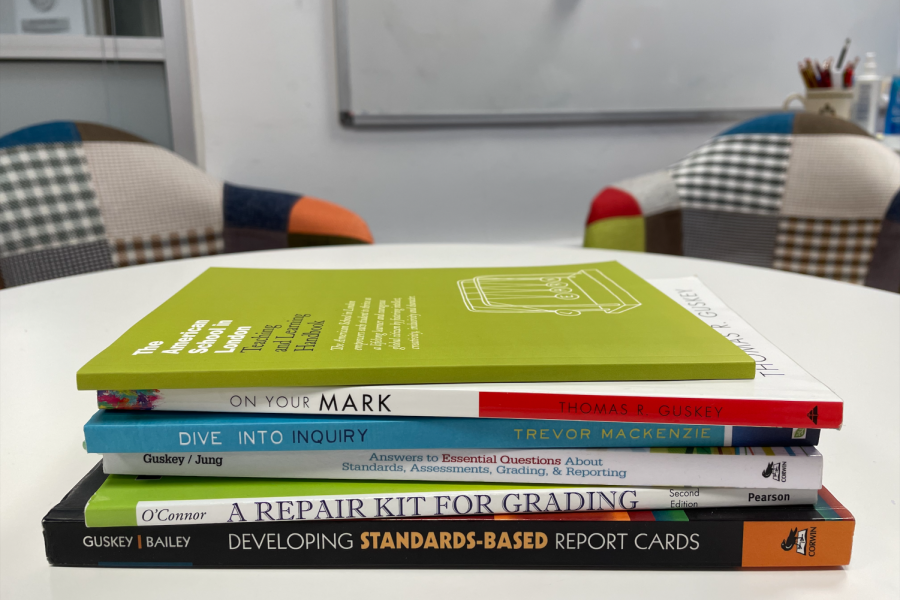Books about approaches to education lie in a pile in Assistant Principal Natalie Jaworksi and Principal Devan Ganeshananthan’s office. According to Director of Teaching and Learning Sarah Donovan Ph.D., the High School has been transitioning to a standards-based learning model.
High School transitions to standards-based learning
Seven years ago, the school set to transition to a standards-based learning model. Students and faculty share their thoughts on the transition’s progress.
February 7, 2022
Standards-based learning is “working its way” through the High School, per Director of Teaching and Learning Sarah Donovan Ph.D.
Donovan said standards-based learning is a model of learning that revolves around the use standards, which are benchmarks for performance.
“Standards-based learning is where we plan for student instruction using standards,” she said. “And so by the end of each course or grade, there’s a specific set of standards that we want and expect that students are going to achieve.”
Implementation and logistics
According to Assistant Principal Natalie Jaworski, standards-based learning has three components: assessing, grading and reporting. Standards-based assessment is when feedback is connected to a rubric, while standards-based grading is when students’ grade in a class is determined by how they perform on the standards rather than a percentage or points system. Meanwhile, standards-based reporting is when a student’s performance on each standard is included in their transcript.
Jaworski said all departments have now implemented standards-based assessing, with the exception of math.
Meanwhile, Donovan said only the Social Studies and World Languages and Cultures departments use standards-based grading. The High School altogether does not use standards-based reporting. Jaworski said there is “no timeline” for fully implementing standards-based grading or reporting.
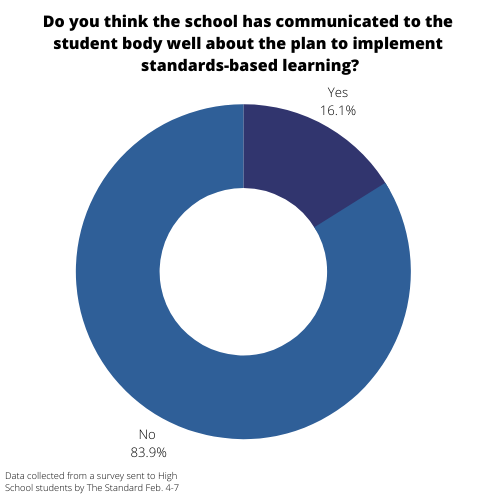
As for impact on grades, there has been nothing noticeable. Jaworski said the school analyzes data, and there has been no inflation in grades since the introduction of standards-based learning.
Furthermore, according to similar data, Donovan said AP scores and college admissions rates have not significantly changed since the implementation of standards-based learning.
Math Teacher and Department Head David Hill said the Math Department plans to move to standards-based assessing eventually, but has no set date. According to Hill, currently, the department teaches by following standards but does not assess according to these standards.
In order to assess students based on learning standards, Hill said the department will test out rubrics they have created which consist of standards that apply to every mathematical topic covered in the High School.
Hill said these “prototype rubrics” will be used on assessments in the Algebra II and Geometry classes this year, and the department will make changes to the rubrics based on how effective and informative they are and whether test results are consistent with previous non-standards-based assessments.
As most classes now use standards-based assessing, Donovan said the High School is now shifting focus to standards-based grading and reporting. Donovan said feedback from students and parents is key in this process.
“When we consider the process, we really want to get student and parent feedback about how student learning is graded and reported on,” she said. “That way, you’re getting information that’s meaningful to you to help you continue to grow in your learning journey.”
According to Donovan, the school made a plan to introduce standards-based learning practices school-wide while conducting a self-study in 2015. This plan was put into practice starting in 2016 and has already been fully implemented by the Lower School and the Middle School.
While this novel approach to education at the school is taking flight, Donovan said the High School has no plans to solely report on standards and remove letter grades so as to avoid conflict with the university admissions process.
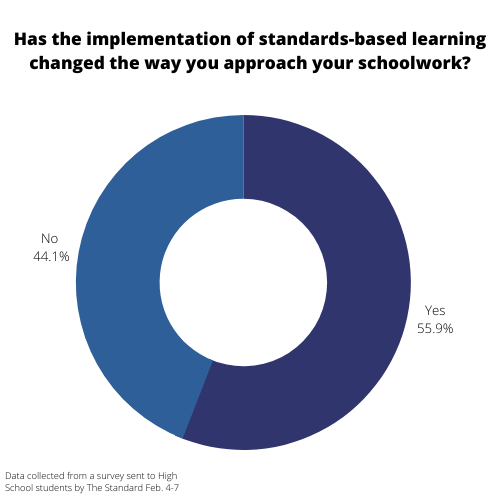
“Even as we consider standards based learning … we’re committed to keeping letter grades in the High School,” she said. “That’s really important for the university admissions process. While you don’t only plan with that process in mind, that’s really important for us. And we know that our students and families want to be competitive in that process.”
According to Donovan, the school has made efforts to educate students, parents and teachers on standards-based learning; students learn the system in their social studies and language classes and teachers complete courses around assessment, learning from professionals. Meanwhile, parents are provided with opportunities to learn about the system through presentations by the school, such as the two standards-based learning webinars held during the 2020-21 school year.
Donovan said standards-based learning is an attempt to create a more effective learning process.
“We want to recognize that we’re not just talking about changing grading,” she said. “We’re talking about being really intentional about how we design learning and how we design assessment and think about how we grade.”
Benefits of standards-based learning
According to Donovan, the goal for standards-based learning is to give students more effective and precise feedback.
Dylan Linton (’23), who has been experiencing the school’s ongoing transition to standards-based learning since his arrival in Grade 9, said it adds layers to the way in which students are assessed.
“Standards-based learning is definitely useful for teachers to kind of, especially in a humanities class, judge a students’ academic ability well,” he said. “Instead of just a single grade that kind of looks at everything at once, you can see different sections of a student’s performance, which can help to point out weaknesses or strengths for them.”
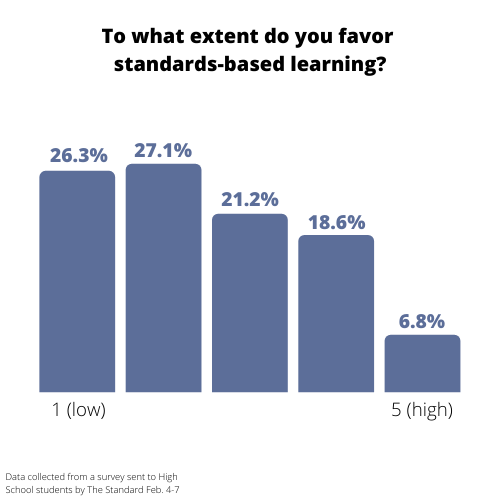
Similarly, Social Studies Teacher and Department Head Chris Wolf said standards-based assessment is more useful than letter-based assessment because students can be guided toward focusing on how to improve instead of fixating on their overall performance.
“Back in the day, you would get a letter grade at the top of your paper,” he said. “So you wrote a six-page paper, and there’s all these comments all over it, and then you get this letter. But you don’t really know ‘Where do I go to make this better?’ based on an overall letter.”
In addition, Wolf said he appreciates that standards-based assessment is built on the understanding that student progress is gradual.
“Knowledge and skills, they aren’t binary, it’s not like a light switch,” he said. “You don’t turn it on and off.”
Likewise, Jaworski said a benefit of standards-based assessment – unlike bell curve grading, which is when grades are sorted in comparison to the best grade in the class – is that it accommodates for diversity in students’ needs and experiences.
“What I love about standards-based assessment is you are not compared to each other,” she said. “You are only on your own learning journey, andthat learning journey is unique to you. Even though we’re all going to try to get to that same place, how each of us get there is different.”
With regard to long-term benefits, Wolf said the use of standards encourages students to think critically, a skill useful beyond just school.
Knowledge and skills, they aren’t binary, it’s not like a light switch. You don’t turn it on and off.
— Social Studies Teacher Chris Wolf
“The system itself kind of helps students develop that sense of judgment about how well they’re doing,” he said. “It’s not like that skill goes away, where they have that judgment, that ability to say, ‘I’m really doing okay on this but not okay on that.’”
Overall, Wolf said standards-based learning gives students more autonomy over their education and increases in effectiveness as they become more familiar with it.
“Standards-based is a great opportunity for students to take more control and to really be in control of their own education,” Wolf said. “I think the more widespread it becomes, the more students will appreciate it and understand it and the better the education will be that they get.”
Drawbacks of standards-based learning
According to a survey sent to High School students Feb. 4-7, out of the 118 respondents, 61% do not think standards should be used to determine their performance in a class.
Despite certain benefits, Linton said standards-based learning does not suit all classes.
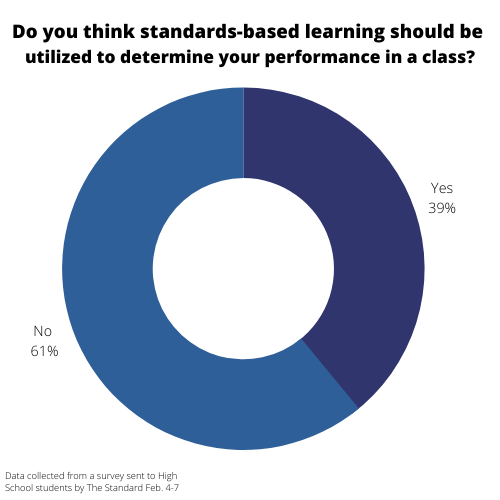
“If it were to be used in a class other than humanities, like a math or science class, I think it’d be harder to implement because a lot of those classes … they’re much easier to do with just raw percentages,” he said. “If we had standards in math, it just wouldn’t— it would feel awkward and not really functional.
Echoing Linton, Olivia Holmberg (’25) said implementing standards-based learning in math classes is unnecessary, and math should continue to follow a percentage system.
“The feedback is quite clear already,” she said. “With the percentages and with the letter grades, you can look through your test, completely understand what’s probably going wrong, and I find it might be a better idea to continue this system now.”
In addition, Holmberg said because assessing via standards is not clear cut, she feels varying performances can end up with the same grade.
However, Donovan said the main drawback of standards-based learning is that since it is a relatively new system, it is unfamiliar for many.
“When you first start with standards-based learning, there is a lot of education for everyone involved – for teachers, for students, for families – because it’s different than what they had before,” she said. “And so the drawback is that it’s change, and that requires time to adjust to.”
Results
Fifty-five percent of High School students said standards-based learning has changed how they approach their schoolwork, according to the same survey.
Linton said standards-based learning has impacted his learning habits.
“I definitely study differently,” he said. “Like for math, it’s just about the content, whereas for U.S. history, I have to worry about not only the content knowledge, not only knowing the material, but how well can I write an essay, how well can I use evidence, analysis and I have to check the rubric and compare my answers.”
Jaworski said one way the school measures the results of implementing standards-based learning is through feedback from teachers.
To be able to see learning change and the conversations that students are having with their teachers change around learning, that’s how we measure our success.
— Assistant Principal Natalie Jaworski
“To be able to see learning change and the conversations that students are having with their teachers change around learning, that’s how we measure our success,” she said.
Furthermore, Donovan said the school surveyed students about their experiences with standards-based learning in social studies and world language.
Through a quantitative lens, Jaworski said the school also uses data to understand the impact of standards-based learning.
“We haven’t seen any, so far, we have not seen any impact on like, what some would call grade inflation – like more kids getting A’s – from using these systems,” she said. “And we’ve looked at that data each year.”
Moving forward
According to the survey with 118 responses, 83.9% of students do not think the school has communicated the standards-based learning plan to students clearly.
Linton said, generally, the student body is left in the dark surrounding the new system and the administration’s plan.
“There is still a lot of ambiguity regarding what the school wants to do with standards-based learning because most of what I’ve heard has been from other students or from teachers and it’s felt like a lot of rumors,” he said. “Whereas in terms of what I’ve actually heard from the school itself, there hasn’t really been anything solid.”
Similarly, Holmberg said standards-based learning is, at first, difficult to “completely understand.” Thus, in order to ease the transition for new students coming from different systems, she said the school must provide “a clear explanation of what standards-based learning is.”
Donovan said the school will continue to examine student and parent feedback throughout the transition.
“My hope next year is that we’ll be working much more closely with parents and students to talk about their experience so far and to talk about what this could look like moving forward,” she said.

